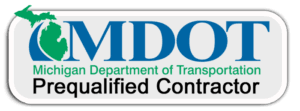Crack Repairs Point Lakeview Michigan
We Are Locally Owned
& Operated For 36 Years
Contact Us Today!
About Crack Repairs
Introduction
Cracks in commercial properties can pose significant challenges and can lead to severe structural problems. Over time, these small breaks can turn into extensive damage, costing property owners thousands in repairs. Crack repairs are hence a crucial part of building management that should never be overlooked, particularly when dealing with commercial properties. This guide will provide an in-depth look at the importance of repairing concrete cracks, methods of crack repair, and the benefits of using quality sealant for cracks. We’ll offer practical tips and real-world examples to help illustrate these points.
The Importance of Crack Repairs in Commercial Properties
Recognizing and responding quickly to cracks can save commercial property owners a significant amount of money in the long run. When left untreated, cracked concrete can lead to structural failure, impacting the safety and habitability of the building. Moreover, it can decrease the aesthetic appeal of the property and subsequently its value. There is, therefore, the necessity for timely and effective crack repair to mitigate these effects.
Common Reasons for Cracked Concrete
The reason for the occurrence of cracks can vary, and its identification can help mitigate future potential damage. Most cracks in concrete structures are due to shrinkage during concrete curing, thermal expansion and contraction, or loads applied to the concrete beyond its tolerance capacity. Other factors can include less than ideal soil conditions or incorrect concrete mix during construction.
Crack Repair Methods
Crack repair methods can vary depending on the extent and type of the crack. Some common methods include sealing, injecting with epoxy or polyurethane, and using concrete overlays or encaustic tiles. These methods aim at bringing the structure back to its original state, ensuring it’s safe, durable, and functional.
Choosing a Quality Sealant for Cracks
When repairing concrete cracks, using a quality sealant is of the utmost importance. An effective sealant will fill and seal the crack, restoring the structural integrity of the building, and preventing future damage caused by water ingress or freezing and thawing cycles. Selecting a high-quality sealant can provide a durable solution that will stand up to wear and tear, having a low likelihood of cracking in the future.
Benefits of Timely Crack Repairs
Proactive crack repairs come with a wealth of benefits. First and foremost, it enhances the safety of the structure, reducing the risk of structural failure. Next, it can serve to prolong the lifespan of the building. Timely repairs also maintain the aesthetic value of the property, presenting a professional look to clients and visitors. Furthermore, with proper maintenance and timely repairs, the property value can also increase, providing a better return on investment when you decide to sell.
Crack Repair and Your Local Expertise
Bearing in mind the significance of quality and timeliness in crack repair, it is essential to choose a trusted and experienced local expert. A local expert will not only be familiar with regional building codes and regulations but also understand the common causes for cracked concrete in your specific area, whether due to climate, soil type, or customary construction practices. Relying on their expertise can result in more effective and long-lasting crack repairs.
Conclusion
Crack repairs might seem like a trivial matter, but this could not be further from the truth, especially when considering commercial properties. Neglecting cracked concrete not only depreciates the property value but also risks the safety of the inhabitants. Consequently, investing in high-quality crack repair and sealant services from trusted local providers proves beneficial in maintaining your property’s value, functionality, and aesthetic appeal. Armed with the knowledge and insight from this guide, you’re ready to address any issues head-on and ensure the best upkeep of your commercial building.
Contact your local professionals today for all your crack repair services and ensure the integrity of your commercial property. Embrace the benefits of prompt, effective repairs, and make a worthwhile investment in your property’s future.
Contact Us Today for a FREE
Crack Repair Quote






About Point Lakeview, Michigan
History
Chesterfield Township was originally established as a general law township in 1842. It became a charter township in 1989.
The original European-American settlement in the area was a hamlet called Chesterfield, first settled in 1830. When the Grand Trunk Railway came through in 1865, it stimulated the development of businesses in the hamlet. It had a post office from 1875 until 1907, but has since lost its specific identity.
Geography
Chesterfield Township is in eastern Macomb County and is bordered on the north by Lenox Township and the village of New Haven; on the east by Ira Township in St. Clair County, and by the village of New Baltimore; on the southeast by Anchor Bay, which is a part of Lake St. Clair; on the south by Harrison Township; and on the west by Macomb Township.
According to the United States Census Bureau, the township has a total area of 30.6 square miles (79 km), of which 27.6 square miles (71 km2) are land and 3.0 square miles (7.8 km), or 9.85%, are water.
Much of Chesterfield Township is dominated by suburban subdivisions and shopping developments; its population is increasingly diverse, reflecting area demographic changes. In 2010 some 89% of the population identified as non-Hispanic whites; in the late 20th century, the largely rural township had an even higher percentage of whites. Anchor Bay influences the southeastern part of the community, where many pleasure boats, docks, and marine-related businesses can be found.
Communities
There are nine unincorporated communities in the township and no incorporated villages:
- Anchor Bay Gardens is located off Jefferson Avenue at Sunrise Street and Jans Drive (42°38′34″N 82°48′45″W / 42.64278°N 82.81250°W; Elevation: 571 ft./174 m.).
- Anchor Bay Harbor is located on Jefferson Avenue south of Anchor Bay Gardens, between Sugerbush and Cotton roads (42°39′19.1″N 82°47′56.7″W / 42.655306°N 82.799083°W; Elevation: 577 ft./176 m.).
- Anchor Bay Shores is located off Jefferson Avenue, south of Anchor Bay Harbor between William P. Rosso Highway and 21 Mile Road (42°38′08″N 82°49′00″W / 42.63556°N 82.81667°W; Elevation: 581 ft./177 m.)
- Chesterfield is located on M-3 from 23 Mile Road to 22 Mile Road. (42°39′46″N 82°50′33″W / 42.66278°N 82.84250°W; Elevation: 607 ft./185 m.)
- Chesterfield Shores is near the border with City of New Baltimore north of Jefferson Avenue and south of M-29/23 Mile Road (42°40′12″N 82°45′41″W / 42.67000°N 82.76139°W ; Elevation: 587 ft./179 m.).
- Fairchild was located in the southern portion of the township. It had a post office starting in 1906.
- Lottivue is located between Jefferson Avenue, Lake Saint Clair, Brandenburg Park and Schneider Road (42°39′34″N 82°45′43″W / 42.65944°N 82.76194°W ; Elevation: 577 ft./176 m.).
- Milton is located at Gratiot Avenue and 24 Mile Road (42°41′21″N 82°49′19″W / 42.68917°N 82.82194°W; Elevation: 607 ft./185 m.) and once was a station on the Grand Trunk Railroad. The first post office in the township was established here in 1837 in the house of Robert O. Milton, with the name of “New Haven Post Office”. When this was moved to New Haven, Alfred D. Rice established another post office in Milton. That post office closed at some point, and another was opened in January 1856, with Edmund Matthews as postmaster. This office operated until July 1904. Milton was home to a school, three churches, a doctor, a blacksmith, and a couple of saloons. The last saloon survived until 2004, when it was torn down, at that time it was known as the “Teddy Bear Bar.” The school, known as Milton School, was incorporated into another building, which was torn down in 2002.
- Point Lakeview is located southwest of Lottivue between the Salt River and Lake Saint Clair.
- Sebille Manor is located northwest of Anchor Bay Harbor between Sugarbush and Donner roads (42°39′40″N 82°48′44″W / 42.66111°N 82.81222°W; Elevation: 587 ft./179 m.).
Demographics
As of the 2010 census Chesterfield Township had a population of 43,381. The racial and ethnic composition of the population was 89.5% non-Hispanic white, 5.3% African American, 0.4% Native American, 1.0% Asian, 0.1% non-Hispanics from some other race, 1.8% from two or more races, and 2.4% Hispanic or Latino.
As of the census of 2000, there were 37,405 people, 13,347 households, and 10,076 families residing in the township. The population density was 1,341.7 inhabitants per square mile (518.0/km2). There were 13,967 housing units at an average density of 501.0 per square mile (193.4/km). The racial makeup of the township was 93.43% White, 2.97% African American, 0.40% Native American, 0.76% Asian, 0.02% Pacific Islander, 0.87% from other races, and 1.56% from two or more races. Hispanic or Latino of any race were 2.52% of the population.
There were 13,347 households, out of which 43.1% had children under the age of 18 living with them, 62.1% were married couples living together, 9.5% had a female householder with no husband present, and 24.5% were non-families. 19.2% of all households were made up of individuals, and 4.7% had someone living alone who was 65 years of age or older. The average household size was 2.78 and the average family size was 3.22.
In the township 29.8% of the population was under the age of 18, 7.9% from 18 to 24, 36.4% from 25 to 44, 19.3% from 45 to 64, and 6.6% was 65 years of age or older. The median age was 33 years. For every 100 females, there were 98.5 males. For every 100 females age 18 and over, there were 95.6 males.
The median income for a household in the township was $61,630, and the median income for a family was $69,554. Males had a median income of $50,834 versus $30,275 for females. The per capita income for the township was $24,410. About 3.9% of families and 4.7% of the population were below the poverty line, including 6.8% of those under age 18 and 3.8% of those age 65 or over.
Government
The township is governed by a board of trustees and a township supervisor. Heavenly Ann Frederick gained presidency in the 2020 election and still holds office.
Fire department
Chesterfield Township is served by a mix of career and part-time firefighters, under the direction of the Public Safety Director, and supervision of a full-time chief. The department staffs two stations 24/7.
Education
Chesterfield Township is primarily covered by two school districts: the Anchor Bay School District, and L’Anse Creuse Public Schools. A small portion of the northern part of the township is also zoned to New Haven Community Schools.
Contact Us Today for a FREE
Crack Repair Quote
Our Crack Repair services are available in Point Lakeview as well as all of Macomb County.
Our dedicated team at D&J Contracting Inc is at-the-ready to provide you with great customer service and first class Crack Repair services. Reach out to us at (586) 954-0008 to discuss your Crack Repair needs today!